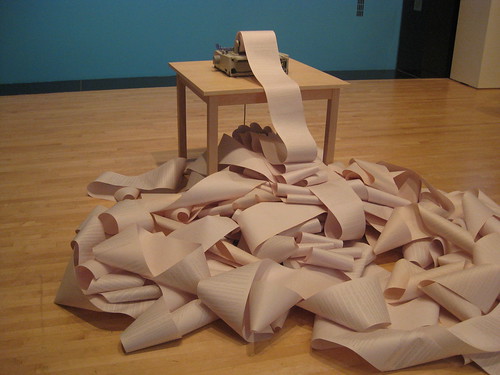Sunday, May 16, 2010
Sunday, May 2, 2010
Audience



Berlin Iron
"This 'new' type of art looks at social reality as a dynamic flux, a moving network of rules/morals and social groupings/alliances that changes and responds to itself. The art in question draws viewers into a focused space to experience this reality, to question/change it and to integrate it into their understanding of self-in-context to the larger social reality." (Art and audience extra reading, first page)
- I found it ironic to find that 'gift' in German means poison, after looking at the Berlin Iron. Which was first used for the Napoleonic wars and then was an exchange for Hitler's cause.
- In these terms, jewelry is a perfect vehicle to question both the inner/private life and its position in the larger public sphere. Jewelry as souvenir, ownership, alliance, physical protection, and spectacle. It is an object that is owned privately, but displayed publicly, meant to be noticed and admired or respected as the Berlin Iron was.
- What happens when an object is a well-crafted simulacra of the jewel, as Kivarkis' work, does the piece signify the same importance and wealth?
- As is later stated in the article with the giving of objects comes an obligatory reciprocity. For jewelry the engagement ring is a great signifier, once given, ownership, marriage and sex was expected, was obligatory.
- Does 'the implication of pleasure as a motive' still ring true in jewelry? In art?
The article also states that the act of giving is seen as altruistic and without ties. In relation to Kandinsky's statement about the artist - "He must realize that his every deed, feeling, and thought are raw but sure material from which his work is to arise, that he is free in art but not in life." (38) Is the artist giving work to society, themself, their field, what is the relationship between artist and society. Give and take, take and take, give and give . . . ?

Doris Betz

Vera Siemund


Anya Kivarkis
Lola Brooks
Saturday, May 1, 2010
Spirituality



"The new harmony demands that the inner value of a picture should remain unified whatever th variations or contrasts of outward form or colour." (Kandinsky, 34) Does this inner unification come through construction? How does construction speak to the inner workings of the soul? The soul seems like an inutitve thing, not one that works as a ladder or a mathematical equation, (
though buddhist imagery shows the change and rise the spiritually enlightened black elephant to a white elephant as a map)
"The spectator is too ready for a meaning in a picture." (Kandinsky, 35) We've become a critical culture. Is it really that the expectation is for a viewer to find meaning in an art piece, or that as a culture we expectat there will be meaning in a piece?
"We stand and gaze fascinated, till of a sudden the explanation bursts suddenly upon us. It is the conviction that nothing mysterious can ever happen in our everyday life that has destroyed the joy of abstract thought." (Kandinsky, 35).
- Does the disillusionment of the unknown expand or diminsh the spiritual?
- Does ullison heighten our sense of reality?
- Ths elitist, cerebral making seems to expect nothing and everything.
"We may be present at the conception of a new great epoch, or we may see the opportunity squandered in aimless extravagance." (Kandinsky 36)
- What has either prediction occured since then? Contemporary examples?
Did Kandinsky succeed in speaking to the inner and not the outer feelings and influences?

Populus Tremula, 2003, Mark Wallinger
A bare aspen with 500, mass produced, lightly scented rosaries

Iris Eichenberg
Sunday, April 25, 2010
Art and it's Institutions
Globalism

Santiago Sierra

Juan Munoz

Andreas Gursky
I understand the cultural restrictions globalism has lifted. People now embrace there heritage whether from Estonia or Dubai. In fact it seems in the current art world to be American or European is boring, not enough flavor. In the art world, is there much cultural american pride?
As a country that is made up of hundreds of origins, can we really have a profound cultural base or just a specific way of life we are accustomed to?
Please look at February 28th's post of Kimsooja's video.
Does globalism, precisely because of its long reach, allow a viable alternative to violent action and open the doors to peaceful protest that will be heard? ex. Eugenio Dittborn and Cildo Meireles Or is that still a fairy tale?
If a person is restricted from leaving their country, is the internet sufficient in truly letting them engage and discover other lands and cultures? How much can a computer screen fill in for real life? (I realize this is a very privilege question to be asking)
Lee - " This 'atmosphere compounded of artistic theories' must be ready for the day when the art world's traditional borders are indivisible from those of the global order we are inclined merely to portray."
From Lee's statement above, if the borders between the art world and the 'real' world are indivisible, how will or can art be avante garde?
Wednesday, April 21, 2010
Subscribe to:
Posts (Atom)





